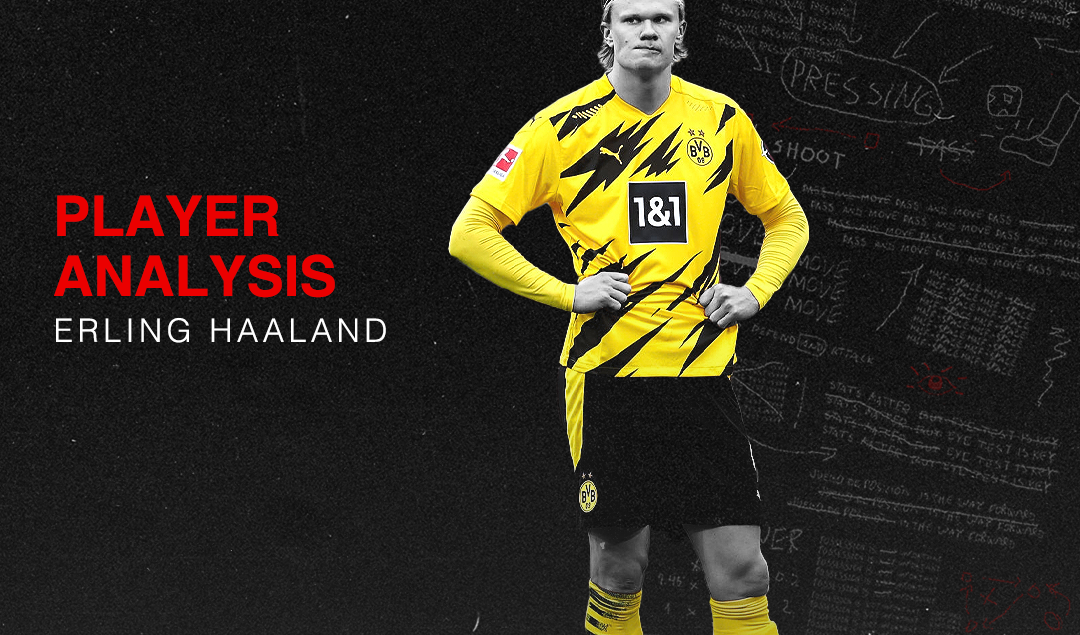Player Analysis: Erling Haaland
Very few players have burst onto the scene quite like Borussia Dortmund’s Erling Braut Haaland, and he has since become one of the hottest commodities in world football. His combination of freakish athleticism and incredible finishing are assets that any team would love to have and at 20 years old, he has the potential to become one of this generation’s greatest players.
Haaland first came into prominence when he scored nine goals against Honduras in the 2019 FIFA U-20 World Cup but it was his performances for RB Salzburg in the Champions League that put him on the map on a world stage. The Norwegian international was able to contribute to nine goals in the group stage against the likes of Napoli and then-defending champions Liverpool.
His exceptional numbers in the Austrian Bundesliga (22 G+A in 14 games) alongside his record in the Champions League convinced die Schwarzgelben to part ways with a measly £18m in January 2020. The striker has gone to hit even bigger heights scoring 49 goals and getting 11 assists in 49 games for the German side. Therefore, clubs such as Real Madrid, Barcelona and both Manchester clubs are all vying for his signature. The question is, what makes Haaland so special?
Movement and Finishing
Simply put, Haaland is a top-class goalscorer. His game is predominantly based around two of his best attributes, movement and finishing, which help him score so often. With regards to his off-ball work, he is one of the best in the world in and outside the box. There are a couple of keys to his success in this department: his intelligence in the sense that he rarely makes the wrong run and his incredible speed and intensity to make those runs.
Haaland’s intelligence links with his positioning as the striker knows the optimum position to occupy. His trademark position is parking himself between two opposition defenders and being on their shoulder. This allows him to run into the box by making a blindside run into the channel – usually on the left channel. In the example below though, he moves into the middle channel and has a great chance on goal.
With the defender focused solely on the ball, Haaland can ghost in behind them without being seen and his superb acceleration makes it extremely difficult to catch him. It should be noted that the striker is very demonstrative with his hands, which makes it clear for his teammates when he’s open and where he wants the ball to be played. This simple move has been a source of many goals for the Norwegian international as when on the left channel, he can open up his body to strike the ball with his first touch across or over the keeper.
This is where his finishing comes into play. The 20-year-old has incredible shot power but has a knack for keeping those strikes low, making it very tough on goalkeepers to save it. However, on some occasions, he likes to mix it up by going for a softer finish and lobbing the keeper. His setup for both finishes can be quite similar in terms of their mechanics so the keeper has little chance of guessing which type of finish he will attempt.
The two pictures below showcase Haaland in a similar scenario. He used his great positioning and movement to run into the left channel in the box and shoot across the keeper into the far post. There is only a subtle difference between both pictures with there being a stronger planted foot and a straight plant leg in the goal against Hertha Berlin (the first picture).
This allows for a more powerful finish whereas against Borussia Mönchengladbach (the second picture), the plant leg is slightly bent. The bend in his leg means Haaland has opted to shoot with less power and is thus, able to chip the keeper into the far post. In both scenarios, he keeps the finish low.
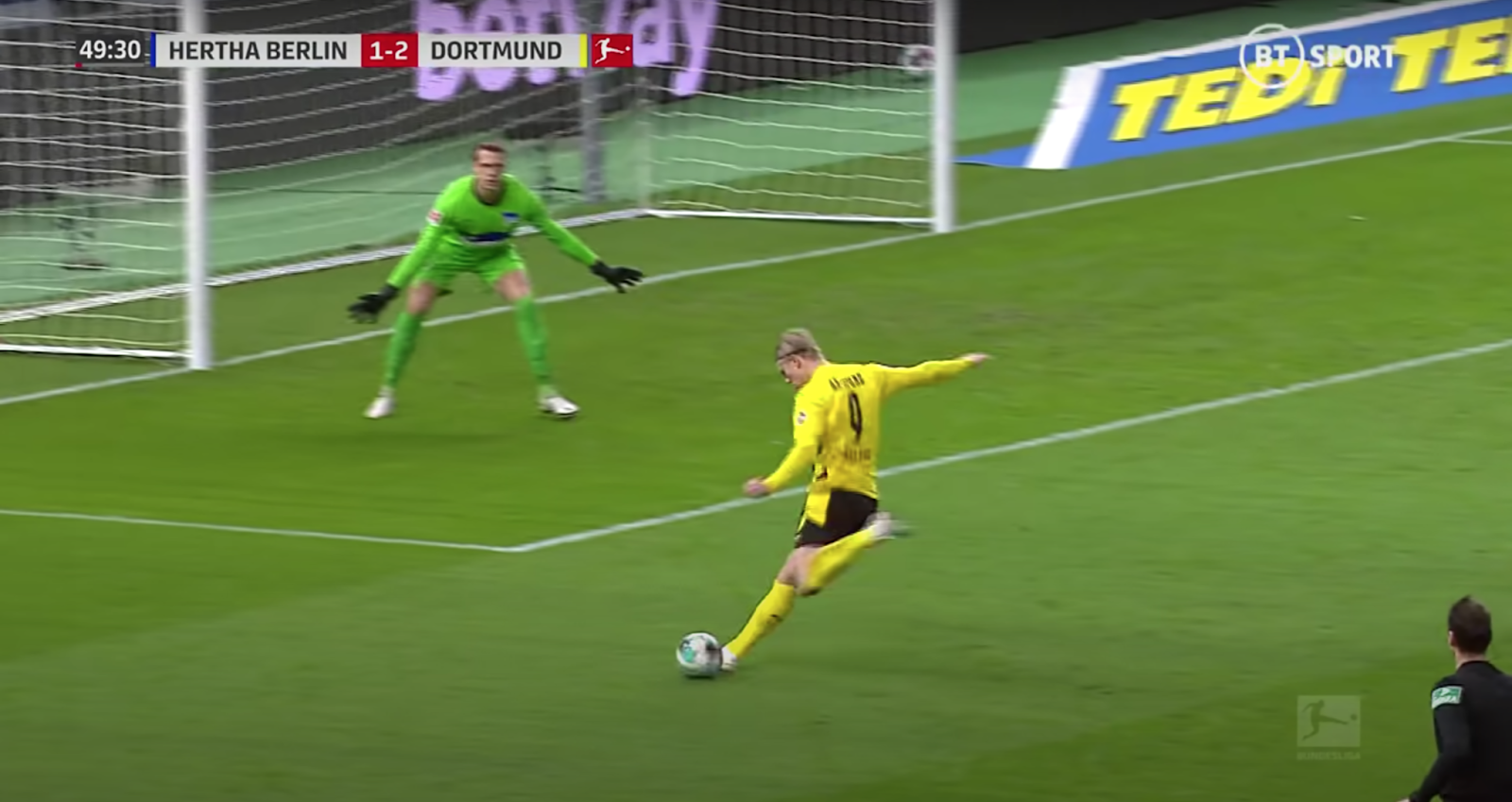
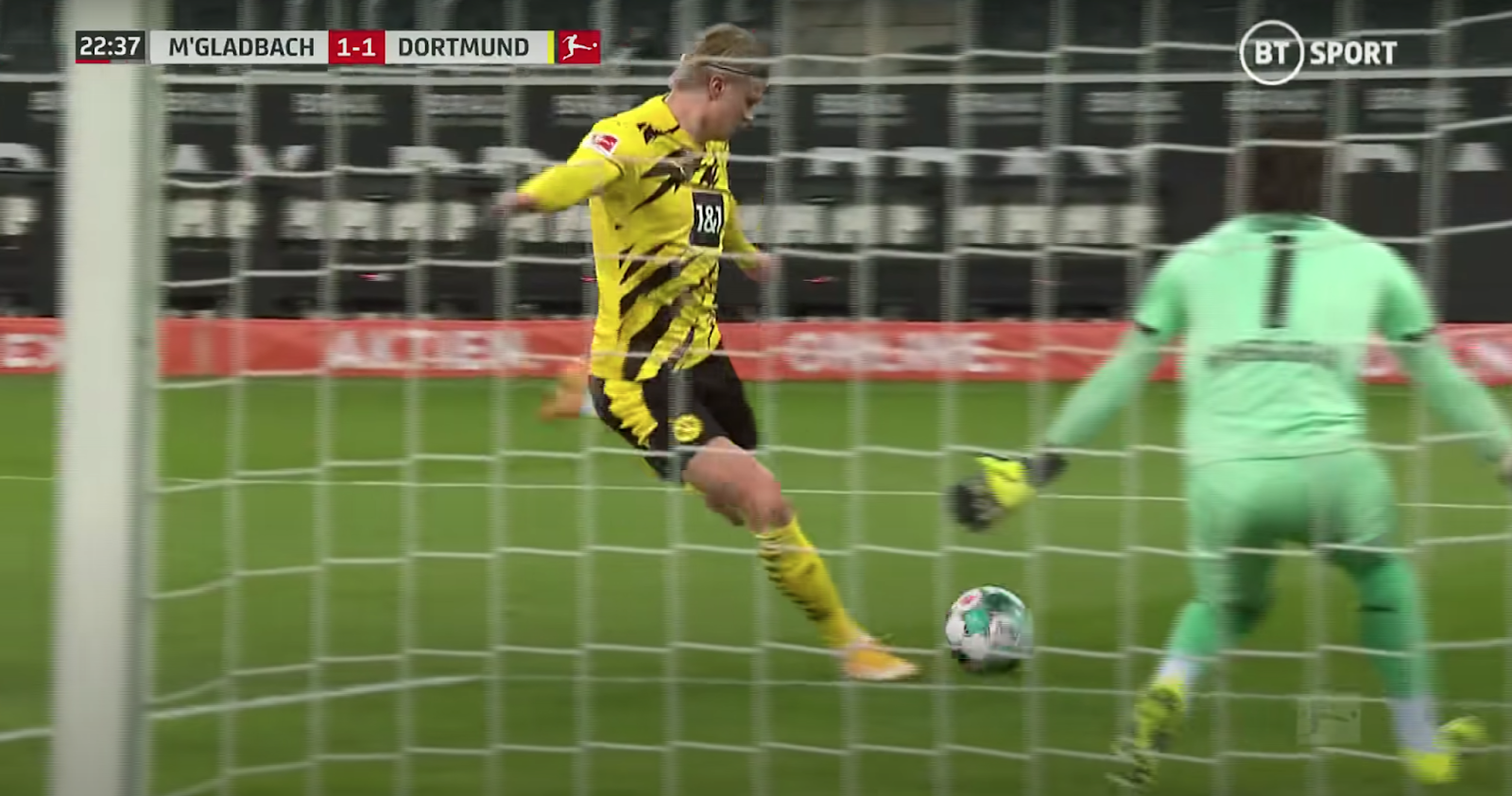
Looking at his shot map from this season via Understat, it’s clear to see that he loves to take shots from the left-hand side of the box but also can get great opportunities close to goal. He is able to find these chances by utilising some great movement patterns inside the box.
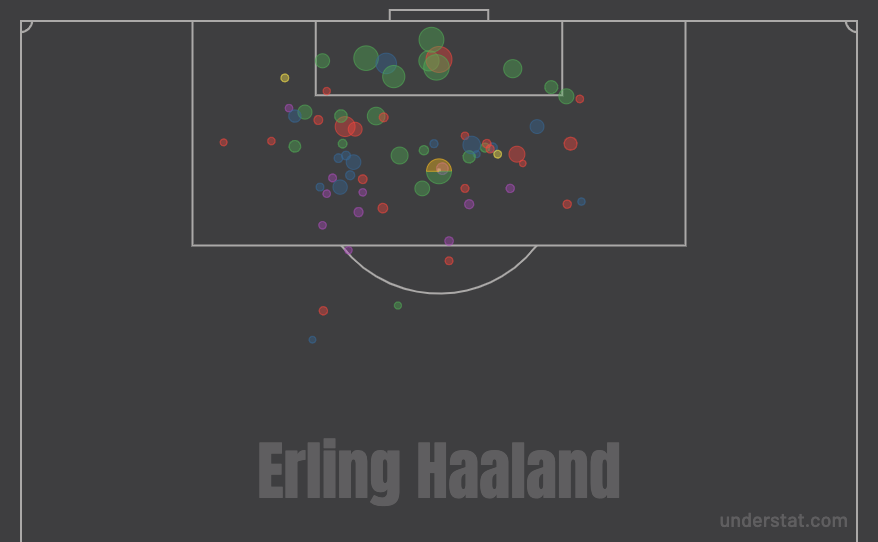
One of the best ways Haaland can find space in the box is by using a feint movement. This allows him to drag defenders to a certain area, usually the near post. He then peels off that defender into space, while the defender is too committed to the first movement by Haaland. This type of movement is key to the striker scoring so many goals, especially from inside the six-yard area as he can use his quick acceleration and movement to create separation in a very tight area.
The example below against Augsburg shows this well. The first picture shows Haaland make a move to the far post when Giovanni Reyna plays a pass back to Raphaël Guerreiro, dragging Augsburg center back Felix Udokhai with him.

When Guerreiro looks to play the ball into the box, Haaland checks back his movement to the front post. Meanwhile, the defender is caught out as he was committed to the step to the far post. This opens up a little bit of space for the striker to have a shot on goal but he puts it high and wide.

We can see a few examples of his incisive movement in matches against Sevilla, Eintracht Frankfurt and Schalke in the below video. He manages to get extremely close to the goal and provide his attacking teammate with a short passing option, before calmly tucking away the goal with just one touch. He has a natural poacher’s instinct, but that doesn’t mean he isn’t a threat from outside the box either.
Haaland is also able to create separation by holding his run in the box. Defenders usually drop back as far as possible when crosses come in so holding a run gives the striker space for a cutback. Crucially, it gives the striker more options. They can either hold their position in the box or make a run on either side of the defender while the defender is essentially waiting for the striker’s movement to make a reaction.
Here, against arch-rivals Schalke, Haaland is in acres of space in the box as he initially tries to make a run to the near post but the ball was not put in the box. Therefore, he backtracked to some space near the far post. This gives him two options: to stay where he is or to run into the far post as a run to the near post is too far. With the Schalke defender opting to not get close to him in the fear of getting beat with a run in behind, Jadon Sancho delivers a great ball to Haaland that he finishes acrobatically.


Looking at his goal record this season, he has 33 goals in 32 games (31 non-penalty goals) for Dortmund in all competitions with nearly a goal per game in the Bundesliga so far. With such exceptional numbers at only 20, it’s fair to ask the question: is this sustainable? To answer this question, we first have to look at Haaland’s expected non-penalty goal-scoring compared to his actual non-penalty goal scoring, which will show us if the striker is overperforming.
The graph below showcases Haaland being one of the best in the world when it comes to goal scoring with only Bayern Munich’s Robert Lewandowski outperforming him in both categories. Haaland has a 1.01 non-penalty goal per game whilst his non-penalty xG per game is at 0.76. This highlights that the 20-year-old is overperforming by quite a lot.

Now that the data suggests that there is some overperformance, we can look at whether it is sustainable in the long term. The graph below looks at over and underperformance per shot with overperformance being a positive value and underperformance being a negative value. This concept was well documented by Kees van Hemmen (@HemmenKees on Twitter) who was also a source of inspiration for other graphs included in this piece.
He identified that a value over 0.05 means that the player is overperforming at their current rate. Likewise, players with values below -0.05 are underperforming and their finishing will improve soon. Haaland is currently at 0.06 so his finishing is bound to regress as he is finishing his chances at an unsustainable rate.

While he is overperforming at the moment, his underlying scoring numbers are still fantastic with high xG and shots per game (85th percentile for strikers in Europe’s top five leagues). So even if he regresses slightly soon, his goalscoring output will still be amongst the best in the world.
Hold-up Play and Creativity
Haaland doesn’t just contribute to the game in and around the box but also in the build-up phase. He has shown glimpses of great work in his hold and link-up play but it is an area that he has to work on. His frame and physicality are key for his hold up play and are great assets for Dortmund as they can launch long balls to him when they need to beat a press. He can either outmuscle players with his strength or use his long legs to flick on passes.
In this example below against RB Leipzig, we can see Haaland use the ‘Hollow Out’ technique to pin the defender even if it is a technique used more frequently by smaller players. He lowers his body position so that the defender can’t gain leverage as his centre of mass is lower, which makes it harder for the defender to push him off balance.
The Norwegian striker’s wide stance helps him with balance as well and allows for a better reaction when the ball gets to him from the throw-in. Given that he is bigger than the defender, it’s harder for him to push his hips back so he uses his back to hold the defender off. He does this by lowering his position even more as seen by his leg being bent at almost a right angle and he uses the defender like a wall to lean on.

Once the ball gets to him, he can receive the ball at an angle such that there is adequate space between the ball and the defender. While it’s quite unclear in the picture, Haaland places his left arm into the chest of the defender to prevent him from getting closer to the ball. Following this play, Haaland plays a one-two with Marco Reus before helping create a goal for Sancho to put Dortmund ahead.
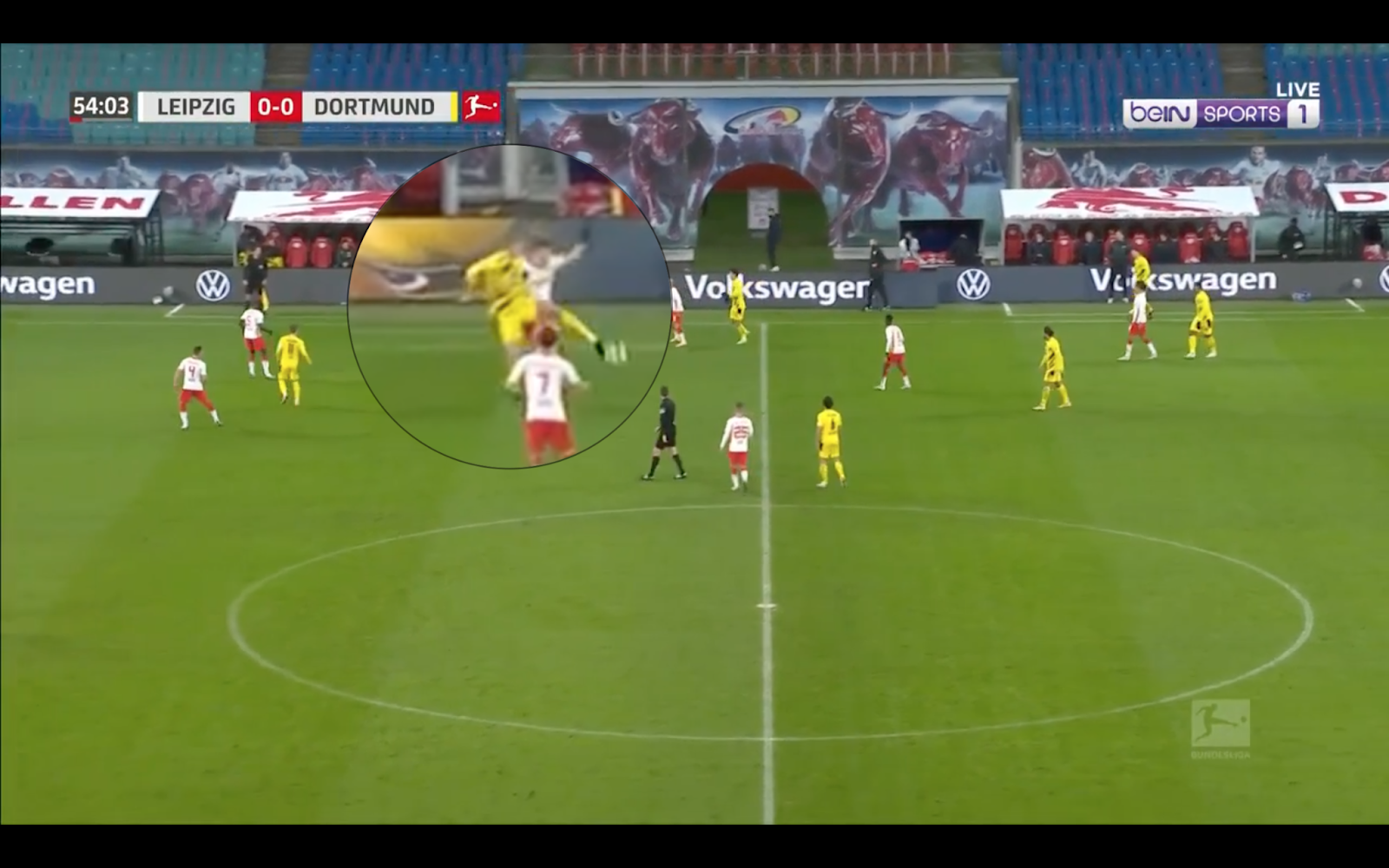
However, there are quite a few times when Haaland doesn’t engage in hold-up situations even when he would have a clear size advantage against the defender. In the same game, the youngster lets the defender get in front of him to win the header when he could have used traditional hold-up techniques to win the ball and lay it off to Reus for a counter. The underlying numbers back this up as he’s only receiving 50.7% passes to him, which ranks in the 20th percentile for forwards in Europe’s top five leagues.
The 20-year-old’s passing tends to be hit or miss and this is reflected in his pass accuracy percentage, which is just above average for strikers at 72.3%. This is largely down to the fact that most of his passes are first-time flicks or layoffs, which are lower percentage passes. While there are occasional good or great passes that are at a higher level of difficulty, Haaland’s execution is usually subpar when the pass has to be played quickly. He tends to overhit passes or is unable to hit the pass into the intended target’s stride, which makes it easier for them to control.
This is an aspect of his game that can be improved but it should not come as a huge surprise that his passing can be weak. There is usually a correlation between players who tend to have better ball control and touch having higher quality in passing. Haaland is not one of those players. His frame makes it difficult for him to control the ball at times as the ball can cannon off his legs quite frequently but it’s an aspect in his game that he is getting better at.
This leads nicely onto his dribbling skill, which is similar to his passing in that he is just above average. However, that is not to say that he can’t still hold his own in this category as there are quite a few positives. His speed and physicality can be a great asset in 1vs1 situations and have helped him complete 56.4% of his dribbles but this is on quite a low volume – 1.68 dribbles per game.
He has also shown some proficiency in controlling the ball in tight areas, which is a positive indicator that he can develop this skill in the future. His ball carrying ability is more effective in open space though as he can then create chances by executing a good pass or having a shot on goal.
So how does Haaland’s skill set in these departments transfer onto impact on the pitch? The focus will be on looking at Haaland’s ability to create as top forwards can facilitate chances for their teammates at a great rate. The graph below displays three different metrics describing creation: shot-creating actions, expected goals assisted and key passes.
The graph shows Haaland being below average in both shot-creating actions and key passes but his 0.19 xA is a promising figure. He ranks in the 87th percentile in this category against forwards in Europe’s top five leagues. It’s clear that he is not generating these quality chances by passing, so is he doing this by dribbling?
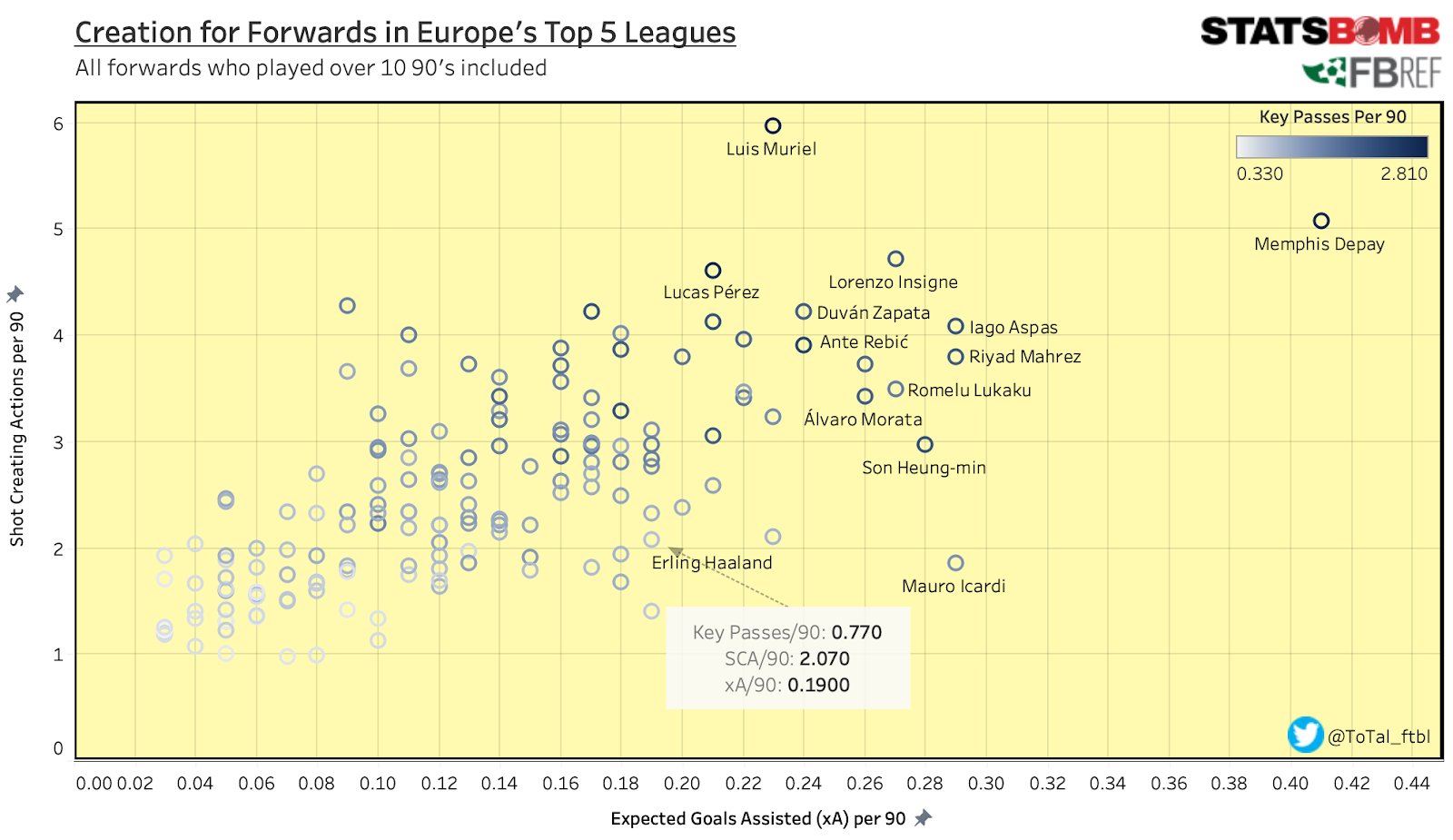
Below is another graph that looks at the shots created via dribbling and fouls won in comparison to dribbling volume. The graph highlights that Haaland, marked in red, doesn’t create a lot of shots from dribbling and doesn’t do this efficiently either. Therefore, he is not creating good quality chances via dribbling either. Instead, he creates great opportunities for his teammates the same way he creates for himself – his off-ball movement.
His high xA attempts usually come from using his blindsided runs into the left channel where he then passes instead of shooting. It should be noted that there’s likely going to be a regression in his xA numbers but he will still be a good level creator for a striker, as he can still create space for his teammates with his movement, occupying defenders, and allowing his fellow attackers to take advantage with more time and space.

His movement also creates space for others because teams are wary of Haaland’s threat so they’ll focus on him, which then opens up gaps in the defence for his teammates to occupy. Note the intensity in his run in the example below against Arminia Bielefeld, as he beats Joakim Nilsson for pace and slides in a pass for Reinier, who coolly beats Stefan Ortega from close range.
Conclusion
Erling Haaland’s explosive scoring and decent to a good level of creation at only 20-years-old makes him one of the most unique prospects to hit the footballing world and a top-class player already. His skill set is still somewhat raw and will need to be developed further as his future employers might be away from the Bundesliga, which is a league that does suit his style. However, he has the right tools to become the most complete striker in the world and can positively impact any top team right now let alone in the near future.
By: Thanoshaan Thayalan
Featured Image: @GabFoligno / Lars Baron – Getty Images
